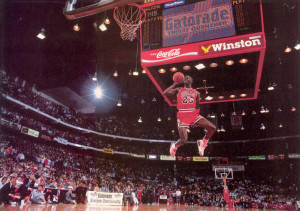Every time I watched Michael Jordan play basketball, I was amazed at how he moved his body over the court, got past defenders, and drove toward the basket. It was as if each of his individual movements were scripted, even though he was really making them up at that instant, his body knowing what to do to be successful. He was able to see openings on the court, just as great running backs are able to see openings on the football field and cut sharply from one direction to another. His body knew and felt its position in space and time. Every movement was automatic. Give him the ball and his body knew what to do with it. Michael Jordan had a great kinesthetic sense. On the other side of the movement spectrum is the infant just learning to walk, whose brain must concentrate on taking a single step forward. The infant is beginning to learn his or her body and how it moves. He or she is developing a basic kinesthetic sense.
Kinesthetics describes the sense of detecting the position, weight, or movement of the muscles, tendons, and joints. The word comes from the Greek word, kinein, to move. It is the root of the words kinesiology, the study of movement; kinematics, the branch of science that studies the motion of a body with consideration to its position, velocity, and acceleration; and kinetics, the branch of science that studies the forces produced by and acting on a moving body. A child, whose brain is just beginning to write the motor pattern for walking, initially has a poor kinesthetic sense, while elite athletes have a great one. Having a good kinesthetic sense means knowing where your body is in space and time as it moves through those two dimensions with incredible ease and fluidity. It is beautiful to watch.
But it is hard to emulate. Many of us have tried to drive to the basket like Michael Jordan, take a slap shot like Wayne Gretsky, drive a ball off the tee like Tiger Woods, or sprint like Usain Bolt. We compare our actions to those of elite athletes and wonder how they can make their movements look so easy as we labor in our attempts. And we notice, through the flurry of slam dunks and goals and tee shots and gold medals, that there is one thing they all have in common—the unfaltering skill to move their bodies perfectly to suit the task.
The ultimate reason why sport is so engaging to the spectator is that it is a form—perhaps the highest form—of art. And the athlete is the master artist, the Picasso. But in sport, as distinct from art, everything actually happens—the movements of the athletes are real, happening in the moment, right before our eyes. Moreover, despite the similarities of movements, each action of the athlete is unique and virtually unrepeatable. The manipulation of the human body to perform beautifully complex movements is one of the most aesthetically pleasing sights in this world. At least to me.
We can learn a lot from the athletes we watch. The process of training necessarily makes us more aware of our bodies and how they perform. The greater awareness improves our kinesthetic sense. Maybe that is why I appreciate running so much—for its constant state of awareness. Putting one foot in front of the other is, after all, one of the most basic movements humans make. It is the purest form of sport. It is the essence of kinesthetics.
One sure way to become a better runner is to improve your own kinesthetic awareness. Feel your body when you run—feel your foot come into contact with the ground and see if you can become aware of which part of your foot touches the ground first. Become aware of where your hips are in relation to your legs. Feel your foot land directly underneath your hips. Feel your large quadriceps muscles stabilize your leg on the ground. Feel your foot leave the ground when you push off. Feel your hamstring muscle contract to flex your leg as your heel comes close to your butt. Feel the air on your face as you effortlessly move over the ground. The more aware you can become of what your body is doing, the greater control you’ll have over your movements and the better runner you’ll be.
Don’t forget to brand yourself as a running expert and get 1.9 continuing education credits from National Academy of Sports Medicine (NASM) and 4.0 credits from American Council on Exercise (ACE) with the Run-Fit Specialist certification. Sign up at http://revo2lutionrunning.com/runfitspecialist.


One Response to Kinesthetics